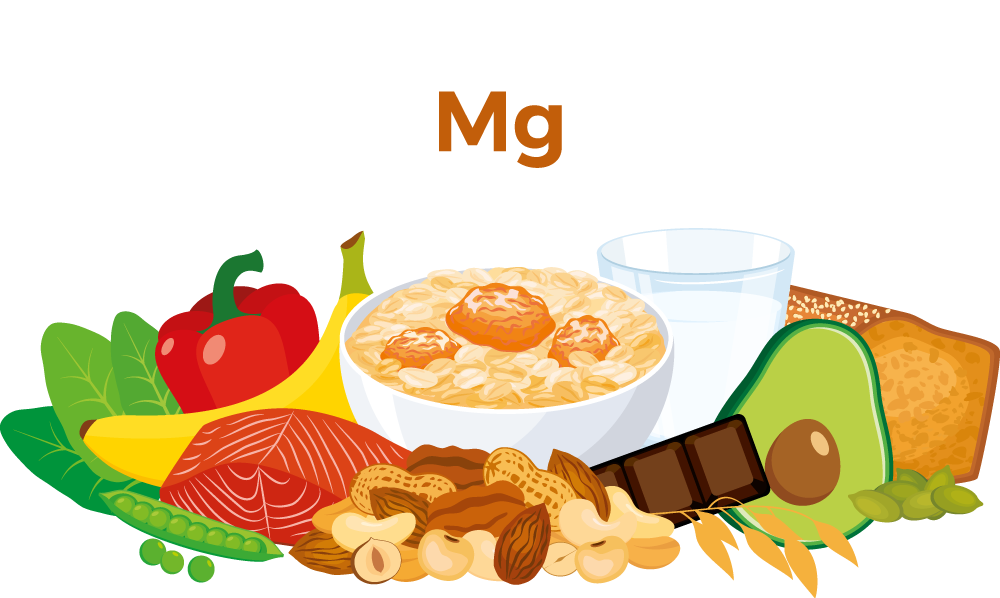Magnesium and Vitamin D: the synergy that can maintain your energy, muscles, and bones after 40
Meet Marta
For the past few months, Marta —47 years old— had noticed that she woke up more tired, that her workouts felt twice as hard, and that she sometimes suffered muscle cramps at the end of the day. Her blood tests showed nothing serious, except for one detail highlighted by her doctor: low levels of vitamin D and magnesium. After adjusting her diet and, under supervision, adding a supplement, she felt energetic and vital again within a few weeks. What happened to her is much more common than it seems…
Does this scenario sound familiar? After the age of 40, many people experience similar symptoms: fatigue, muscle stiffness, or low mood. Maintaining adequate levels of magnesium and vitamin D can benefit your daily life.
Benefits you may notice with adequate magnesium and vitamin D levels
When these nutrients are balanced in the body, energy remains stable throughout the day, muscles feel more relaxed and cramps decrease, mood stabilizes, and joints and bones stay strong. Additionally, during months with lower sun exposure, natural defenses are strengthened, helping the body respond better to minor challenges typical of these periods.
(Effects are associated with mechanisms recognized by EFSA - European Food Safety Authority - and supported by scientific studies. They do not replace a balanced diet or medical treatment.)
Two often-overlooked micronutrients working together for your benefit
The symptoms Marta experienced are not uncommon: with age, stress, and modern diets, magnesium and vitamin D levels tend to drop in many people. This can manifest as fatigue, muscle cramps, stiffness, or mood dips, even when general health seems good.
The interesting part is that these two nutrients work together. Magnesium is needed to activate vitamin D in the body, while vitamin D helps magnesium absorption in the intestines. Therefore, taking care of both in balance can enhance their effects and naturally improve well-being.
Vitamin D: much more than the “sunshine vitamin”
Vitamin D is involved in multiple functions, from bone formation and maintenance to immune system regulation and muscle function. While the body can synthesize it when exposed to sunlight, this ability decreases with age, and many people have suboptimal levels, especially during months with less sun.

Natural sources of vitamin D
The most well-known way to get vitamin D is through sun exposure, always with caution to avoid skin damage. It is also found in fatty fish like salmon, sardines, or mackerel, as well as in eggs and dairy or plant-based products enriched with this vitamin.
Including these foods regularly can help maintain healthy levels, although supervised supplementation may be recommended in some cases.
Scientific study
A randomized clinical trial published in 2020 in the Journal of Clinical Medicine involved middle-aged women with low vitamin D levels who received supplementation for 12 weeks. At the end, participants showed significant improvements in muscle strength —especially in handgrip and mobility tests— as well as a reduction in body fat percentage.
EFSA has approved the following health claims for vitamin D:
- Vitamin D contributes to the maintenance of normal bones.
- Vitamin D contributes to the normal functioning of the immune system.
- Vitamin D contributes to the maintenance of normal muscle function.
Magnesium: the mineral of balance
Magnesium participates in over 300 enzymatic reactions, including those responsible for energy production, muscle relaxation and contraction, and nervous system regulation. Deficiency of this mineral can lead to fatigue, cramps, or nervousness, symptoms often attributed only to stress or tiredness.

Natural sources of magnesium
It is abundant in nuts such as almonds and cashews, legumes, whole grains, and green leafy vegetables. Regular consumption of these foods helps maintain adequate magnesium levels.
For some people, especially if their diet is low in these foods, magnesium supplements can be a useful option.
Scientific study
A study published in the American Journal of Clinical Nutrition (2018) observed that adequate magnesium levels enhance vitamin D efficacy and improve its metabolism.
EFSA recognizes the following health claims for magnesium:
- Magnesium contributes to the reduction of tiredness and fatigue.
- Magnesium contributes to the normal functioning of muscles.
- Magnesium contributes to the normal functioning of the nervous system.
- Magnesium contributes to normal energy metabolism.
The synergy between magnesium and vitamin D
The body needs to convert vitamin D into its active form to perform its functions. This process requires enzymes that depend on magnesium as a cofactor. Therefore, magnesium deficiency can prevent vitamin D from being properly activated. Conversely, vitamin D promotes magnesium absorption in the intestines, creating a positive feedback loop.
In practice, this means supplementing vitamin D without ensuring sufficient magnesium may limit the benefits, and vice versa. A balanced combination of both nutrients, especially after 40, helps improve energy, bone health, muscle function, and natural defenses.
When to consider supplementing with vitamin D and magnesium
Supplementation may be considered in the following situations:
- Limited sun exposure, especially in winter or if regular sunscreen is used.
- Frequent muscle cramps, persistent fatigue, or joint stiffness.
- Poor diet lacking nuts, legumes, green leafy vegetables, or fatty fish.
- Chronic stress, which may increase magnesium loss through urine.
Consulting a healthcare professional and, if possible, measuring blood vitamin D levels helps choose a safe and adequate dose.
How to integrate them into your daily routine
Effectively incorporating magnesium and vitamin D does not require drastic changes. The first step is a balanced diet: include nuts, legumes, leafy greens, and whole grains to maintain magnesium, and consume fatty fish, eggs, and fortified products to ensure vitamin D.
When using supplements, consistency and quality are key. Vitamin D3 combined with magnesium usually provides better results. Some people also add vitamin K2 to help calcium reach the bones instead of accumulating in arteries.
You can buy Vitamin D and buy marine Magnesium in our Anastore shop.
It is recommended to take supplements daily and, if possible, with meals that enhance absorption. Effects are not immediate: after a few weeks of consistent use, improvements in energy, muscle tone, and general well-being may be noticed.
Finally, maintaining healthy habits complements supplementation: moderate physical activity, adequate rest, and stress management help the body make the most of these nutrients.
Magnesium and vitamin D form an essential duo after 40 because they can lead to:
- More energy and less fatigue, thanks to magnesium.
- Strong bones and muscles, thanks to vitamin D.
- Better immunity and mood, thanks to the synergy between the two.
Taking care of these micronutrients in a balanced way is a natural and scientifically supported approach to maintaining long-term well-being.

Bibliography
- Effect of Vitamin D Supplementation on Muscle Strength, Muscle Function, and Body Composition in Vitamin D-Deficient Middle-Aged Women (2020).
- COMMISSION REGULATION (EU) No 432/2012 of 16 May 2012 establishing a list of permitted health claims made on foods, other than those referring to the reduction of disease risk and to children’s development and health.
- Dai Q et al. Magnesium status modifies the association between vitamin D and mortality. Am J Clin Nutr. 2018;108(6):1249–1258.